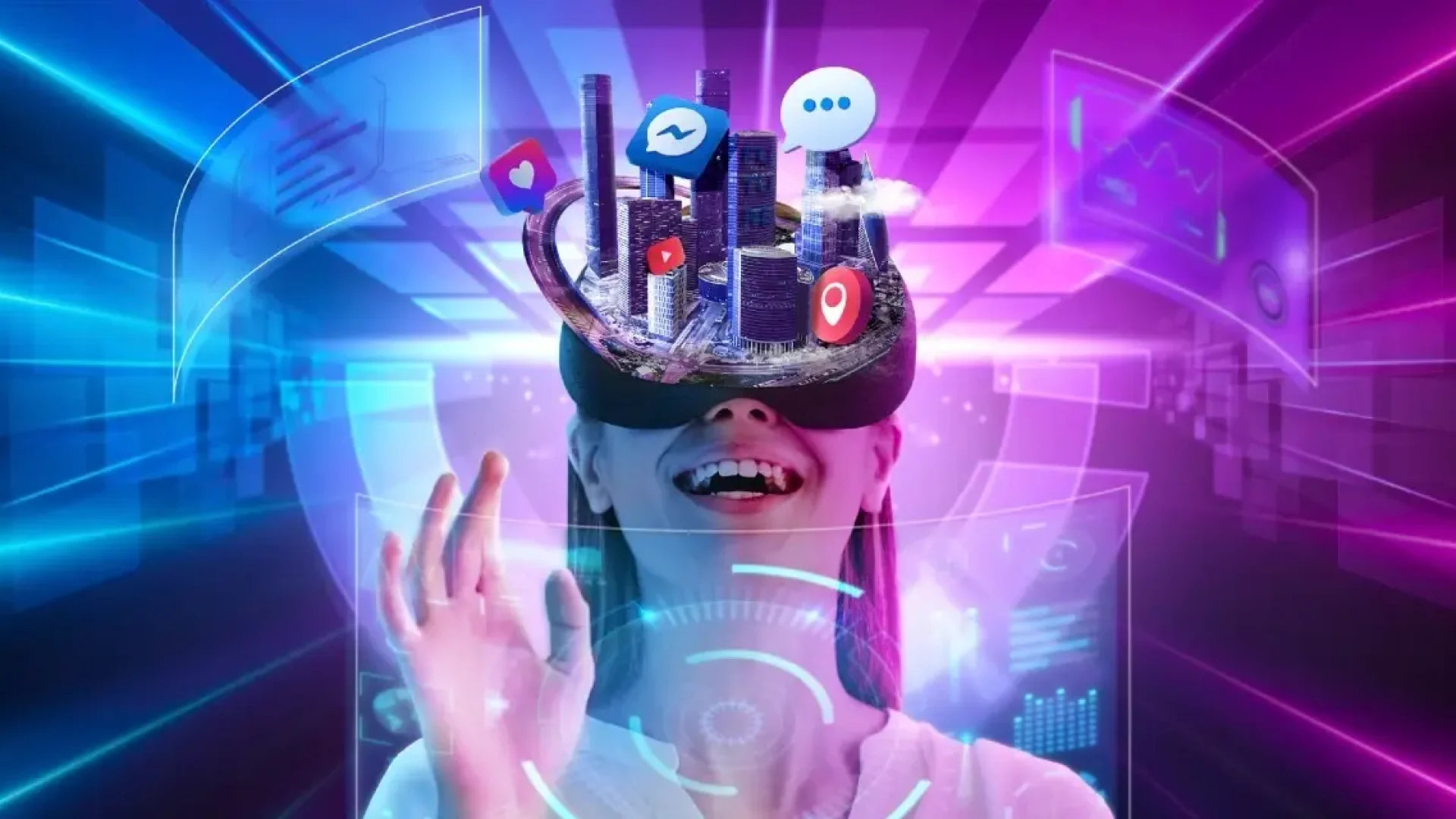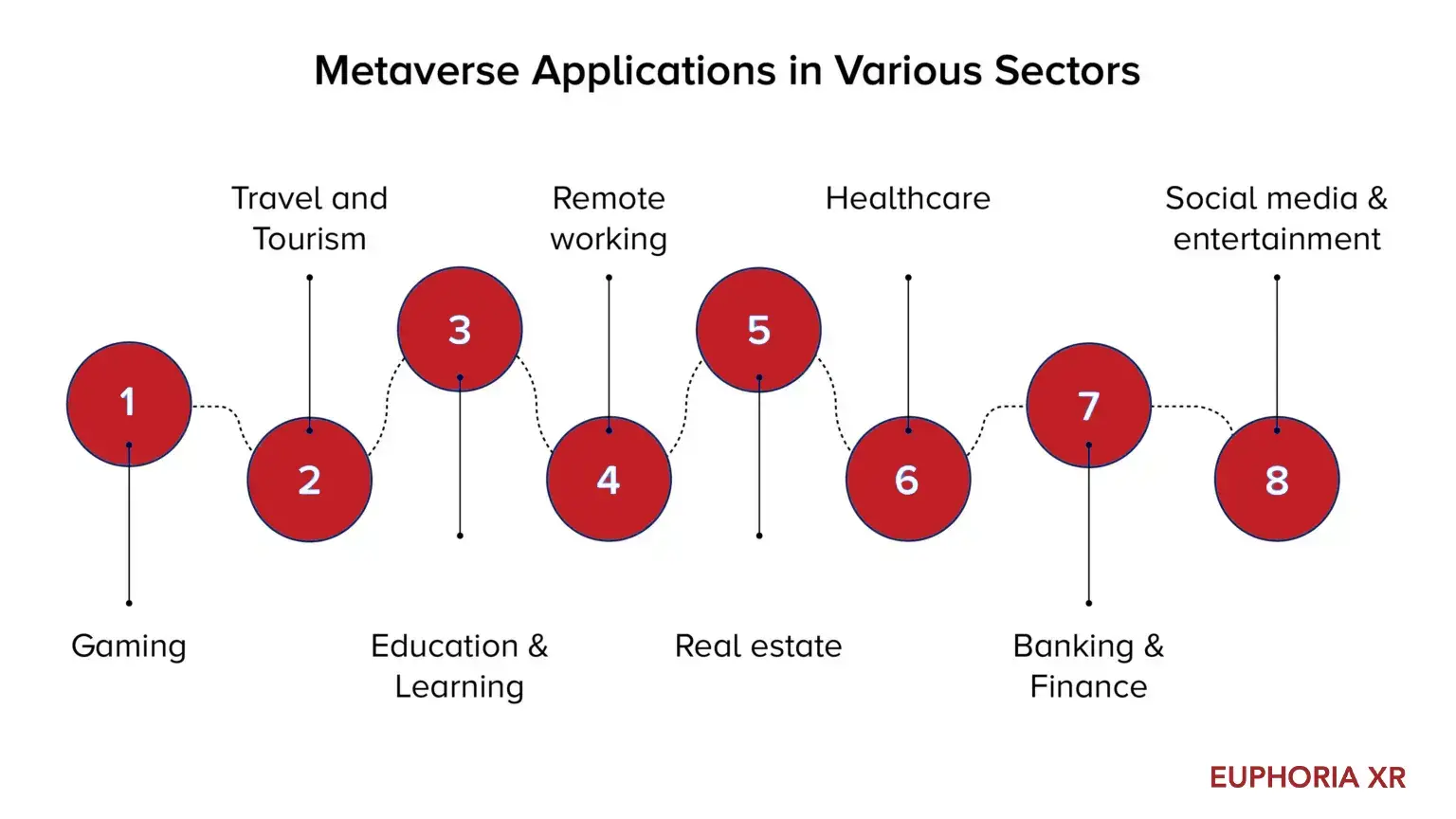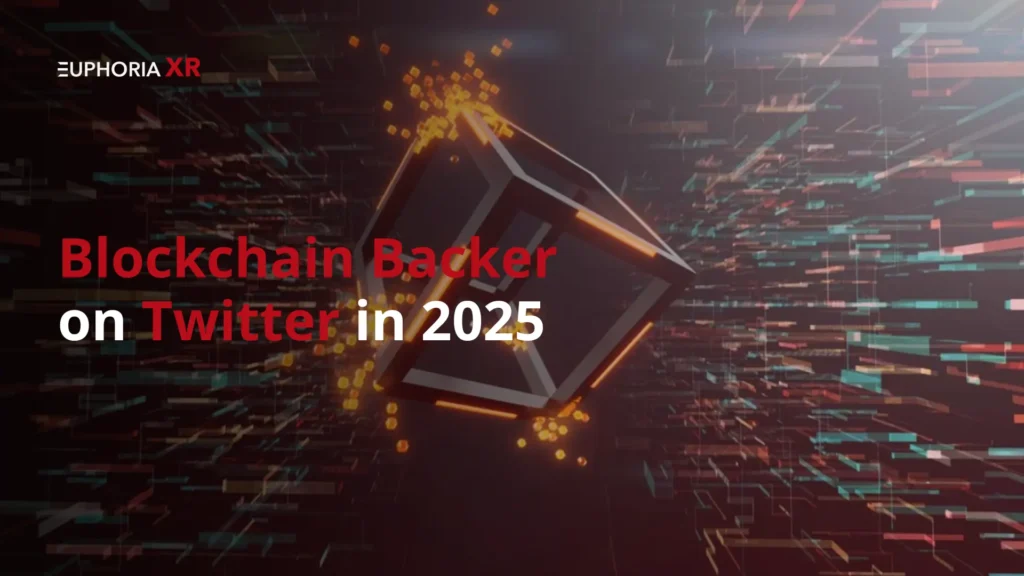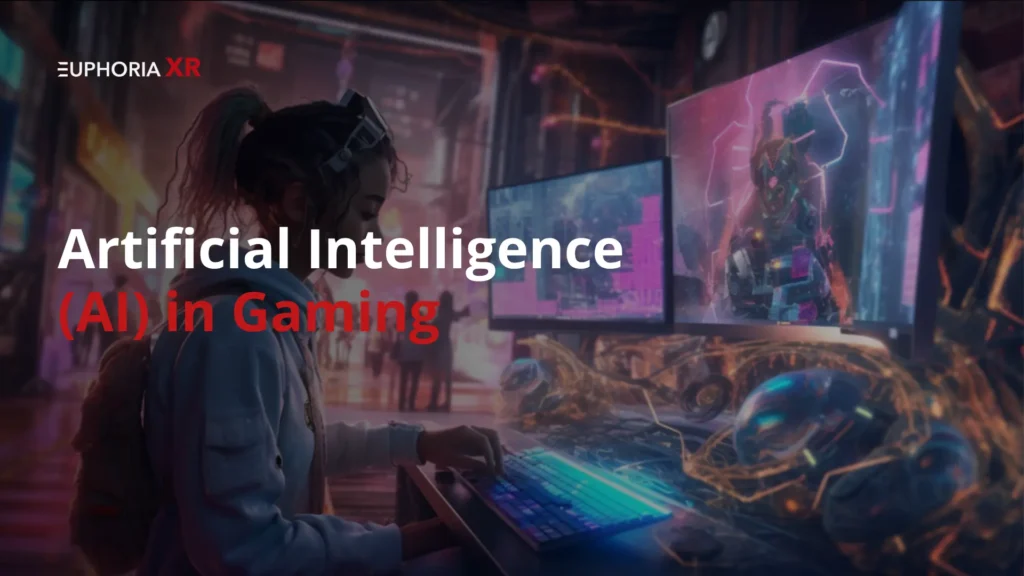Has the buzz around the metaverse reached your ears? It’s the hottest topic in the tech sector, promising a unique blend of digital and physical media. The phrase “Metaverse” has recently gained much attention in the IT community, capturing the interest of specialists and regular internet users. But what exactly is it? Is it merely a future vision, or is it already influencing how we use technology? We will explore the world, top firms, industries, definition, history, and hopeful future of the metaverse.
Let’s find out.
So fasten your seatbelts and prepare to enter an infinitely fascinating universe outside the screen.
What is the Metaverse?
The term “metaverse” describes the merging of virtual and real worlds. It is a three-dimensional online environment accessible through computers made possible by immersive technologies like mixed reality (MR), augmented reality (AR), and virtual reality (VR).
Imagine the digital and real worlds merging seamlessly. That’s what the metaverse is all about. With customized avatars, users can interact in real-time communication, participate in immersive activities, and even possess virtual goods.
Digital and hybrid spaces coexist in the metaverse. Users in the Metaverse can engage in any activity offered in this virtual world, which resembles an online, networked virtual environment with digital goods, NFTs, avatars, etc. To view our comprehensive guide on the Metaverse and its impacts on various industries.
A Short History of the Metaverse
Interestingly, the metaverse’s origin tale started in the previous century, despite the present enthusiasm surrounding it! The term originated in the pages of a science fiction novel, not in a tech lab.
In his dystopian science fiction book Snow Crash, author Neal Stephenson first used the term “metaverse” in 1992. The novel envisioned a virtualized society in which an avatar’s technological aptitude played a role in determining a person’s social standing. Snow Crash’s portrayal of a networked 3D world has impacted actual web programs like Google Earth and NASA World Wind, in addition to introducing the idea of digital avatars.
Ernest Cline’s Ready Player One, published in 2011, further popularized the idea of the metaverse. This novel was then turned into a successful movie directed by Steven Spielberg. In the future depicted in the novel, individuals attend The Oasis, a virtual reality environment accessible via VR headsets and haptic gloves that imitate human touch, to escape the harsh realities of their everyday lives. The idea of haptic feedback has grown to be an essential component of the metaverse that we currently see.
Although science fiction stoked people’s imaginations, the fundamental technologies necessary to make the metaverse a reality have been developed since the 1960s. Two previous “hype waves” disappeared from the public eye—the first in the early 2000s, when the ground-breaking virtual world platform Second Life saw a boom followed by a decline, and the second in 2010, when the first VR headsets failed to bring about the metaverse revolution that their designers had envisioned—are part of the legacy of the metaverse. But these bursts of enthusiasm and the adjustment that followed prepared the way for important technological developments that pushed us closer to the metaverse we may yet experience in the present.
Metaverse Applications Across in Different Industries
Metaverse is more than just a catchphrase; it’s a ground-breaking idea that can completely change how we engage with the digital world. It is a large universe of interconnected virtual experiences with applications that touch every aspect of our lives, far from being isolated.
More than forty percent of the most recent developments in virtual reality and augmented reality are already creating the framework for the metaverse. Let’s explore some of the most interesting Metaverse Application cases from a variety of sectors:
1. Metaverse in Tourism and Travel Industries
Imagine climbing Mount Everest or seeing the Taj Mahal in breathtaking detail from the comfort of your home. For individuals unable to travel conventionally, the Metaverse offers immersive experiences that enable virtual tourism to become a reality. With 360° virtual tours generated by AR and VR, you can experience unmatched realism when exploring stunning sites. Here’s an interesting guide about the amazing impacts of AR/VR in the travel and tour industry.
Thomas Cook’s “Try Before You Fly” campaign is a good example, as it lets prospective travelers digitally see their ideal locations before making travel plans.
2. Metaverse in the Gaming Industry
When adopting the Metaverse, the gaming sector is leading the way. Envision expansive virtual environments where participants can work together on challenging missions, attend live performances with friends worldwide, or even possess virtual property. With their inventive features and millions of active players, games like The Sandbox, Sorare, and Axie Infinity demonstrate the power of the Metaverse. Games in the metaverse go beyond conventional experiences by providing:
- Successful Social Hubs: Establish a feeling of community within the virtual world by connecting and interacting with other gamers on a deeper level.
- Play-to-Earn Economies: Increase player engagement and motivation by earning bitcoin through gameplay.
- Smooth Mixed Reality: Experience a genuinely immersive virtual environment by seamlessly navigating between various communication types.
- NFT-powered Ownership: Guarantee durability and worth by genuinely possessing the in-game assets symbolized by NFTs (Non-Fungible Tokens).
3. Metaverse in the Education Industry
Education takes on a whole new dimension because of the Metaverse. Integrating Virtual Reality with Metaverse effects enhances the educational process by giving students access to top-notch resources and live experiments in a dynamic setting. There are countless opportunities for exciting and productive learning—just picture taking a virtual spaceship tour of the solar system or dissecting a virtual frog.
In addition, the Metaverse allows students from different backgrounds to study together in a digital environment, overcoming language barriers. This may be seen in Microsoft’s Mesh platform, which offers a mixed-reality environment where staff, instructors, and students can communicate via 3D avatars.
4. Metaverse in Healthcare
Healthcare is changing as a result of the Metaverse! Imagine therapy sessions in serene virtual surroundings, surgeons working remotely on intricate procedures, or doctors and patients interacting in virtual clinics.
This is how the Metaverse can transform the healthcare industry:
- Upgraded Telehealth: For a more engaging session, visit a virtual clinic instead of making a video call.
- Remote Surgery Revolution: The Remote Surgery Revolution enables surgeons worldwide to work together in real-time through virtual reality tools, increasing access to specialist treatment.
- Medical Education is Changing: The Metaverse provides a new approach to teaching and training medical professionals through interactive simulations and 3D models.
- Enhances Mental Health: Virtual environments can provide support groups for mental health issues and safe venues for exposure therapy.
- Rehab Gets a Rewind: Engage in more meaningful rehabilitation by performing physical therapy activities in a virtual environment with real-time feedback.
- Personalized Care: The Metaverse can facilitate improved patient tracking and tailored treatment regimens by enabling the creation of a “digital twin” for each patient.
The future of healthcare in the Metaverse is bright, with more accessible, collaborative, and individualized care for everybody. However, issues like accessibility and data privacy need to be addressed.
5. Remote Work
The Metaverse is revolutionizing conventional business models. Companies like Nike, Intel, and YouTube are already adopting virtual office spaces powered by the Metaverse. Through VR training simulations, staff members can obtain real-world experience in a secure setting. For a complete educational experience, this experiential training blends interactive digital components, manuals, and movies.
However, the Metaverse offers more than just instruction; it also makes distant employment possible in ways previously impossible. Team members may work together effortlessly from any location using virtual workplaces with VR-enabled communication capabilities. This eliminates geographical obstacles and promotes a sense of community and connection among remote workers.
Furthermore, 3D avatar-based collaborative meetings raise the bar for distant communication by letting participants engage in virtual spaces that closely resemble actual locations. The Metaverse provides several tools to facilitate remote collaboration and innovation, ensuring that teams can work together productively regardless of physical distance. These include interactive project spaces and virtual boardrooms.
6. Metaverse in the Real Estate Industry
The real estate business is a fantastic fit for The Metaverse because of its exceptional ability to create immersive virtual experiences. Virtual tours are a helpful tool for realtors to show homes because they save clients from physically visiting numerous sites.
Prospective purchasers can virtually tour properties in real-time from the comfort of their homes, checking out every little detail. These virtual tours are unique in that they allow users to customize their experience by changing the tour to meet their unique needs and interests. Traditional property viewing experiences are exceeded by the Metaverse’s amount of personalization, which extends from room layout to wall color scheme.
7. Meatverse in Banking & Finance
One should pay attention to the Metaverse’s potential in the banking industry. With the promise of a radical change in how clients engage with their banks, metaverse banking represents the start of a new era in financial services. The days of long lines and physical branches are long gone; in their place, Metaverse banking delivers a 360-degree virtual experience that crosses national borders and enables easy remote access to financial services from any location.
Imagine entering a virtual bank branch from the comfort of your home, where helpful virtual assistants assist you with financial planning and transactions. Metaverse Banking customers can immerse themselves in a digital world where financial services are only a click away by navigating virtual surroundings using their laptops, mobile devices, or VR headsets.
8. Metaverse in the Social Media & Entertainment Industry
Metaverse technology has completely transformed the field of social media and entertainment, bringing a brand-new era of digital engagement and immersion. Platforms like Meta (previously Facebook) lead this change, investigating new commercial prospects in the metaverse. Through Meta’s vision of a connected metaverse, users can travel around virtual areas, attend virtual events, and communicate with friends and family using lifelike avatars. The metaverse is reimagining social media as a dynamic and participatory environment where people can authenticate themselves, from virtual gatherings to shared experiences.
However, the metaverse’s influence goes beyond social networking sites and changes the entertainment sector. Immersion experiences are used by eCommerce, fashion, and athletics industries to engage consumers in new and creative ways. Imagine going to a live performance in a virtual venue where you can connect with other fans and even meet the artist backstage, or imagine visiting a virtual fashion show where you can browse the newest trends and buy products with just a click.
Metaverse Future Trends
The Metaverse is a dynamic environment that is always expanding its limits of possibility. The following are some of the most popular trends influencing its growth:
1. Hyper-Immersion
This movement is about making virtual worlds more realistic and captivating. Technological developments in VR, AR, and haptic interfaces will blur the boundaries between the physical and virtual worlds, allowing us to experience a fully Immersive Metaverse. During a virtual skydiving journey, picture yourself feeling the wind blow against your body or the texture of virtual items.
2. Interoperability
An essential principle of the Metaverse is ensuring that users can easily move between various virtual platforms and experiences with their avatars and digital assets. Imagine using the same avatar to explore a virtual museum on one platform after attending a virtual concert hosted on another. This interconnectivity increases the Metaverse’s possibilities and creates a sense of continuity.
3. The Emergence of the Creator Economy
The Metaverse creates a vibrant environment for creators to develop and profit from their virtual worlds, experiences, and assets. Growing platforms enable users to create interactive games within the Metaverse, build 3D buildings, and design virtual fashion items. This encourages creativity and allows users to actively participate in reshaping the virtual environment.
4. The Combination of Blockchain and NFTs
In the Metaverse, blockchain technology is essential for proving who owns what and verifying digital assets. Examples of unique digital things NFTs represent are avatars, artwork, and virtual land parcels (Non-Fungible Tokens). Through this connection, consumers may exchange and profit from their digital assets on many platforms while ensuring safe ownership.
5. The Physical and Digital Convergence
The Metaverse cannot exist in a vacuum. Digital and tactile experiences will merge. Imagine buying a virtual item that activates a related physical product or going to a performance where the actual venue is enhanced with virtual components. This merging of realities results in a more complex and integrated experience.
6. Metaverse Governance and Regulation
As the Metaverse gets more connected with our daily lives, concerns about rules and regulations will surface. A responsible and long-lasting Metaverse will require defining ownership rights, maintaining user safety, and resolving privacy issues.
7. Put Accessibility and Inclusivity First
As the Metaverse develops, it will be critical to ensure it is both accessible and inclusive. This involves developing technologies that can accommodate various users with different skill levels. Everyone ought to be able to engage meaningfully and feel at home in the Metaverse.
8. The Rise of AI-powered Avatars:
Artificial intelligence (AI) will help our avatars become more complex. Deepening our sense of connection in the Metaverse, these AI avatars can pick up on our preferences, adjust to changing circumstances, and even communicate our emotions.
These developments hint at the fascinating future that surrounds the Metaverse. We can expect an increasingly immersive, engaging, and limitless virtual environment as these tendencies come together and technology progresses.
Top Metaverse Development Companies
A Metaverse development company plans to build and manage Metaverse’s platforms, experiences, and infrastructure. These companies create virtual worlds, social media platforms, gaming environments, and other digital spaces within the Metaverse setting. To create engaging and dynamic user experiences, they frequently use technologies like blockchain, augmented reality, virtual reality, and artificial intelligence (AI).
A few well-known Metaverse development companies are as follows:
- Meta
- EuphoriaXR
- LeewayHertz
- Aetsoft Inc.
- Innowise Group
- Accenture
- Program-Ace
- iTechArt
- Quytech
- Capgemini
These businesses and others are critical in determining how new experiences shape the Metaverse’s future. In particular, EuphoriaXR provides excellent Metaverse Development Solutions that stimulate imagination and creativity in the digital sphere.
The Future of Metaverse
The Metaverse has a bright future, but numerous unresolved issues exist. Here’s a sneak glimpse at potential future developments:
A More Immersive Experience
Imagine your face being brushed by a virtual wind or holding a textured digital object. Developments in VR, AR, and haptics will produce hyper-realistic experiences that obfuscate the distinction between the actual and virtual worlds.
Smooth Interconnectivity
The Metaverse will consist of only a few separate platforms. Consider utilizing your avatar and digital belongings to transition between virtual worlds. For example, you could use your avatar to visit a museum on one platform and attend a concert on another.
A Booming Creator Economy
The Metaverse will serve as the center for creators’ creation and commercialization of virtual goods and experiences. Anticipate systems that let players create interactive games, build buildings, and design virtual clothing inside the Metaverse.
The Power of Blockchain
Blockchain technology will securely own and verify NFTs, virtual land, and artwork. Users can exchange and profit from their digital assets across platforms.
The Fusing of Realities
The distinctions between digital and physical reality will keep collapsing. Imagine purchasing a virtual item that unlocks a tangible product in the real world or going to a performance where virtual components enhance the actual venue.
Developing Avatars
Our digital friends will grow increasingly intelligent. Avatars with AI capabilities will be able to communicate with us more deeply in the Metaverse by picking up on our preferences, changing with the times, and even expressing emotions.
Emphasis on Accessibility
Ensuring everyone can participate in the Metaverse as it expands is critical. Technologies that meet a range of demands and abilities will be created. Consider using voice commands or VR controllers that have been particularly made to navigate the Metaverse.
Challenges and Regulations
As the Metaverse grows, issues with rules and governance will surface. Determining ownership rights, guaranteeing user safety, and handling privacy concerns will be essential to building a responsible and long-lasting virtual environment.
The Metaverse has an exciting future, but overcoming these obstacles will be necessary to grow. There is no denying that the Metaverse has the power to completely transform how we work, live, and engage with the world.
WrapUp:
The Metaverse is a door to a cosmos full of possibilities, not just a futuristic catchphrase. Imagine yourself in a future where the lines separating the real and virtual worlds disappear, experiences go beyond our screens’ constraints, and the possibilities for creation are endless. The Metaverse has the potential to completely transform how we interact, learn, work, and play.
Ready to explore this thrilling new land? EuphoriaXR, a top Metaverse development company in the USA, is creating innovative virtual experiences at the forefront. We provide a potent fusion of technical know-how, creative knowledge, and a drive to push the limits.
Get in touch with Euphora right now, and together, let’s create your Metaverse vision! We can influence this virtual planet’s destiny and open up endless possibilities.
















